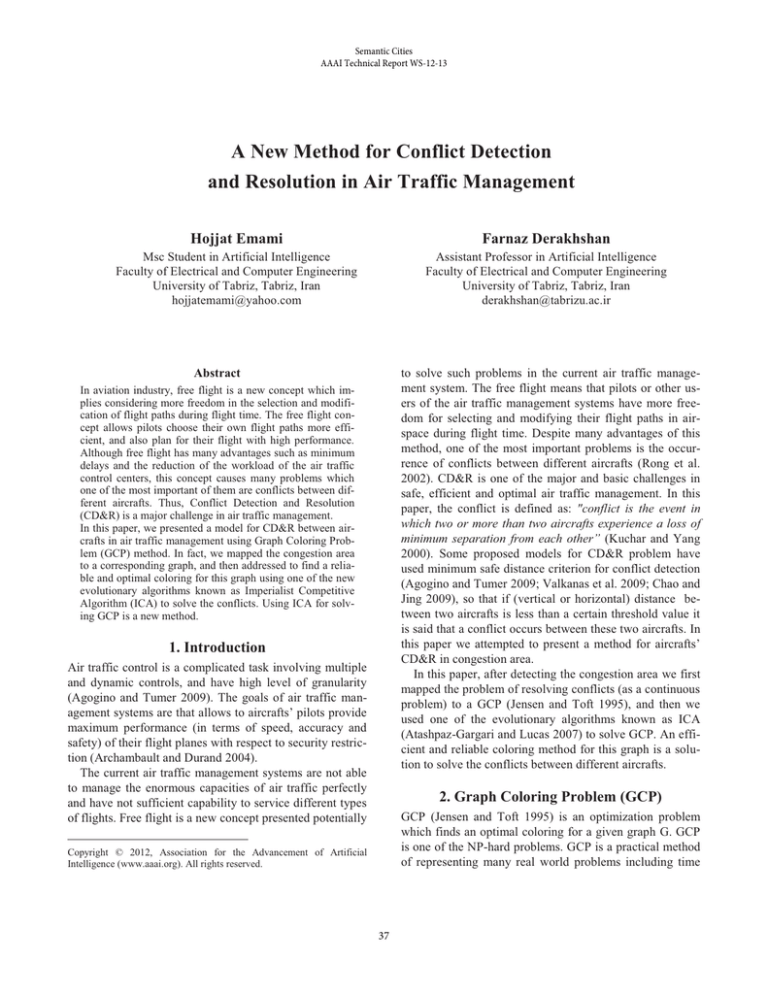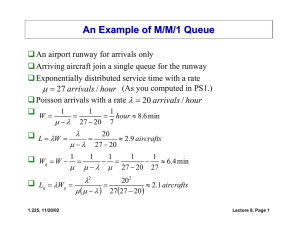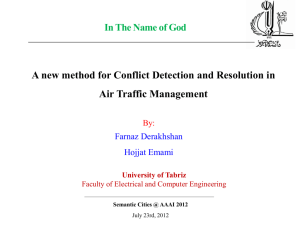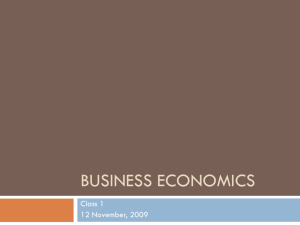A New Method for Conflict Detection Hojjat Emami
advertisement

Semantic Cities AAAI Technical Report WS-12-13 A New Method for Conflict Detection and Resolution in Air Traffic Management Hojjat Emami Farnaz Derakhshan Msc Student in Artificial Intelligence Faculty of Electrical and Computer Engineering University of Tabriz, Tabriz, Iran hojjatemami@yahoo.com Assistant Professor in Artificial Intelligence Faculty of Electrical and Computer Engineering University of Tabriz, Tabriz, Iran derakhshan@tabrizu.ac.ir to solve such problems in the current air traffic management system. The free flight means that pilots or other users of the air traffic management systems have more freedom for selecting and modifying their flight paths in airspace during flight time. Despite many advantages of this method, one of the most important problems is the occurrence of conflicts between different aircrafts (Rong et al. 2002). CD&R is one of the major and basic challenges in safe, efficient and optimal air traffic management. In this paper, the conflict is defined as: "conflict is the event in which two or more than two aircrafts experience a loss of minimum separation from each other” (Kuchar and Yang 2000). Some proposed models for CD&R problem have used minimum safe distance criterion for conflict detection (Agogino and Tumer 2009; Valkanas et al. 2009; Chao and Jing 2009), so that if (vertical or horizontal) distance between two aircrafts is less than a certain threshold value it is said that a conflict occurs between these two aircrafts. In this paper we attempted to present a method for aircrafts’ CD&R in congestion area. In this paper, after detecting the congestion area we first mapped the problem of resolving conflicts (as a continuous problem) to a GCP (Jensen and Toft 1995), and then we used one of the evolutionary algorithms known as ICA (Atashpaz-Gargari and Lucas 2007) to solve GCP. An efficient and reliable coloring method for this graph is a solution to solve the conflicts between different aircrafts. Abstract In aviation industry, free flight is a new concept which implies considering more freedom in the selection and modification of flight paths during flight time. The free flight concept allows pilots choose their own flight paths more efficient, and also plan for their flight with high performance. Although free flight has many advantages such as minimum delays and the reduction of the workload of the air traffic control centers, this concept causes many problems which one of the most important of them are conflicts between different aircrafts. Thus, Conflict Detection and Resolution (CD&R) is a major challenge in air traffic management. In this paper, we presented a model for CD&R between aircrafts in air traffic management using Graph Coloring Problem (GCP) method. In fact, we mapped the congestion area to a corresponding graph, and then addressed to find a reliable and optimal coloring for this graph using one of the new evolutionary algorithms known as Imperialist Competitive Algorithm (ICA) to solve the conflicts. Using ICA for solving GCP is a new method. 1. Introduction Air traffic control is a complicated task involving multiple and dynamic controls, and have high level of granularity (Agogino and Tumer 2009). The goals of air traffic management systems are that allows to aircrafts’ pilots provide maximum performance (in terms of speed, accuracy and safety) of their flight planes with respect to security restriction (Archambault and Durand 2004). The current air traffic management systems are not able to manage the enormous capacities of air traffic perfectly and have not sufficient capability to service different types of flights. Free flight is a new concept presented potentially 2. Graph Coloring Problem (GCP) GCP (Jensen and Toft 1995) is an optimization problem which finds an optimal coloring for a given graph G. GCP is one of the NP-hard problems. GCP is a practical method of representing many real world problems including time Copyright © 2012, Association for the Advancement of Artificial Intelligence (www.aaai.org). All rights reserved. 37 scheduling, frequency assignment, register allocation and circuit board testing (Whalen 2002). For any given graph, finding the minimum number of colors is the fundamental challenge. This is often implemented by using a conflict minimization algorithm (GAREY and JOHNSON 1999). The GCP can be stated as follows: Given an undirected graph G with a set of vertices V and a set of edges E (G= (V, E)), a k-coloring of G includes assigning a color to each vertex of V, such that neighboring vertices have different colors (labels). Formally, a k-coloring of G=(V, E) can be stated as a function C from V to a set of colors K such that |K|=k and C (u) ≠ C (v) whenever E contains an edge (u, v) for any two vertices u and v of V. The minimal number of colors allocated to a graph is called the chromatic number of G. Optimal coloring is one that uses exactly the predefined chromatic number for any given graph. After forming initial empires, the Assimilation policy apply on the colonies in each of empires and start moving toward their relevant imperialist country. All empires try to take the possession of colonies of other empires and control them. The imperialistic competition gradually provides a decrease in the power of weaker empires and an increase in the power of more powerful ones. In the basic version of ICA the imperialistic competition is modeled by just picking some of the weakest colonies of the weakest empire and making a competition among all empires to possess these colonies. Assimilation Policy and Imperialist Competition are the most important and basic operators in the ICA. 4. Our Proposed Model In our model, the main strategy is based on: "Prevention is better than cure". If we use the prevention strategy, thus we do not automatically allow any conflicts occur. In this case, firstly, it is not essential to have a plan for detecting conflicts, and consequently, it is not necessary to resolve the conflicts. Although in this model we tried to have a preventive approach, we attempted to present a method for CD&R. In our proposed model, the criterion of conflict detection is the reduction of the (horizontal) distance between aircrafts of a certain limit. The diagram of our proposed model is shown in figure 2. As shown in figure 2, the traffic environment must first be monitored and appropriate current state information must be collected (using proper equipment (Kuchar and Yang 2000)). In this stage, the minimum reliable distance threshold and other necessary traffic information can be determined too. 3. Imperialist Competitive Algorithm (ICA) In this paper, we use a new evolutionary algorithm for solving the GCP which is inspired by imperialistic competition. ICA is a new socio-politically algorithm motivated by global search strategy that has recently been introduced for dealing with different optimization tasks. This evolutionary optimization strategy has shown great performance in both convergence rate and better global optimal achievement, therefore in this paper we used of ICA rather than other evolutionary algorithms. Figure 1 shows the pseudo code of the ICA. Similar to other Evolutionary Algorithms (EAs), this algorithm starts with an initial population. Each individual in this population is called a country. Some of the best countries (i.e. countries with the minimum cost value) are selected to be the imperialist states and the rest of individuals form the colonies of these imperialists. All colonies of initial countries are divided among the mentioned imperialists based on their total power. The imperialist states together with their colonies form some empires. Start - Define Problem Parameters - Minimum Reliable Distance Threshold - Other Traffic Information 1) Initialize the empires. 2) Move the colonies toward their relevant imperialist (Assimilation). 3) Randomly change the position of some colonies (Revolution). 4) If there is a colony in an empire which has lower cost than the imperialist, exchange the positions of that colony and the imperialist. 5) Unite the similar empires. 6) Compute the total cost of all empires. 7) Pick the weakest colony (colonies) from the weakest empires and give it (them) to one of the empires (Imperialistic Competition). 8) Eliminate the powerless empires. 9) If stop conditions satisfied, stop, if not go to 2 - Detect the Congestion Area - Compute Distance between all Aircrafts in Congestion Area - Map the Congestion Area to a Graph - Make the Adjacency Matrix Solving the GCP using ICA (Conflict Resolution process) Colored Graph / Proposed solution for conflicts End Figure 1: Pseudo code for the basic version of ICA. Figure 2: Block diagram of our proposed model. 38 Then the congestion area is detected based on state information of the current air traffic. For example, for every specific area if the number of aircrafts is more than a predefined reliable number then we can consider that area as a congestion area. The number of aircrafts and their relevant information can be saved in a knowledge database. For example we can obtain this information using by Global Positioning System (GPS). We map the congestion area to a corresponding graph; in fact we create the adjacency matrix based on traffic information. After this stage, we color this graph (i.e. conflict resolution process) by using ICA. The output of this algorithm is a reliable solution for conflicts between aircrafts. the early convergence of individuals to local optimal. As the assimilation operator, this operator needs to be changing too. We implemented the revolution operator by the mutation operator as in genetic algorithm (Werra 1990; Goldberg 1980). Also, in changed version of ICA imperialist competition is implemented similar to what proposed method in basic version of ICA. In the conflict resolution process, for each aircraft, we allocate a flight path in which this aircraft will has a reliable distance with other aircrafts and there is no risk of conflict. In this model, a Global approach is used for resolving the multiple conflicts (Kuchar and Yang 2000). 5. Test Results 4.1. Creating the Graph To evaluate our proposed model, we use simulation environment (especially we use random flights model) that is same to one used in (Archibald et al. 2008). All aircrafts are constrained to fly at the same altitude and at a constant speed. Small and instantaneous heading changes for each aircraft are the only maneuvers of resolving conflicts. For this reason we use examples and supposed scenarios. These samples contain 2, 3, 4, 5, 6, 8, 12, 16, 20 and 30 aircrafts in congestion area. The results are presented in Table 1. The results indicate that the proposed model is often providing optimal and valid solutions for input corresponding graphs (aircrafts’ congestion area). In air traffic control we deal with a multi objective problem. In this paper, our goal is providing a safe, reliable and efficient strategy for solving conflicts between aircrafts in air traffic. We can use of different metrics to evaluate proposed model; here we used System Efficiency metric. The ideal state in a proposed model for resolving conflicts in air traffic is that the aircrafts are able to track their destination without deviation or with minimal deviation from their original path. Maneuvers that are used in the conflict resolution methods, causes the aircraft to be diverted from the ideal and optimal mainstream. System efficiency measures the degree to which the aircrafts in the system are able to follow direct and linear flight paths to their destinations (Archibald et al. 2008). In this paper, we define a performance criterion for each aircraft same as follows: As we mentioned we map the congestion area to a graph. Here the nodes of graph indicate aircrafts in the congestion area and every edge between two nodes indicates a probable conflicts in the future time step, if the aircrafts continue their current flight plan. In this model, we can assume each flight path as five directional options namely: main line, deviation to right of the main line, deviation to left of the main line, top of the main line and bottom of the main line. The graphical display of creating the graph of a supposed scenario is shown in figure 3. Figure 3: Graphical display of an example conflict resolution scenario (creating the graph). Path length = (length of main path) - (length of revised path) 4.2. Solving Graph Coloring Problem using ICA Or in other words: The basic version of ICA used for optimization of continuous functions, since in the GCP we deal with discrete search space, hence we changed some basic operator (such as assimilation operator and revolution) in ICA. The goal of Assimilation operator is that the colonies are more similar to the imperialist. To implement this operator for solving the GCP, we used 2-point crossover operator similar the crossover operator in genetic algorithm. The revolution operator increases the exploration of the ICA and prevents Ei = ⎛ P ⎜ i ⎜ P +P ⎝ i di ⎞ ⎟ ⎟ ⎠ Where Pi is the ideal and optimal flight path for an aircraft and Pd is the amount of deviation from mainstream of airi crafts. We try to select routes with lowest cost when we redirect the aircrafts’ main routes (i.e. the lowest deviation from the main 39 flight path for each aircraft). It is assumed that the predefined main routes to fly aircrafts are optimal. Then we consider effi- Although, in this paper we presented only an abstract, preliminary and conceptual model for CD&R, nonetheless our next goal is that we will focus on using this model with multi-agent systems technology to present a comprehensive model (especially to CD&R) that have high efficiency compared to other available models. ciency of the system as follows: System Efficiency (SE) = 1⎛N ⎞ ⎜∑E ⎟ N ⎝ i=1 i ⎠ Where N is the total number of aircrafts in the system (i.e. in the congestion area) and Ei indicates the performance of each aircraft. How much this criterion is closer to “1” indicates good performance of the system and how much this criterion is closer to zero indicates poor performance and conflict resolution system is inefficient. Our proposed model for solving GCP for higher dimensions (for a great number of aircrafts that are in the congestion area) acts as a good way. References Rong, J., Geng, Sh., Valasek, J., R. Ioerger, T. 2002. Air traffic conflict negotiation and resolution using an onboard multi agent system. Digital Avionics systems Conf. Irvine, CA. Kuchar, J., and Yang, L. C. 2000. A Review of CD&R Modeling Methods. IEEE Transactions on Intelligent Transportation Systems, Vol. 1, No. 4, December. Agogino, A., and Tumer, K. 2008. Adaptive Management of Air Traffic Flow: A Multiagent Coordination Approach. Proceedings of the Twenty-Third AAAI Conf. on Artificial Intelligence. Agogino, A., and Tumer, K. 2009. Improving air traffic management with a learning multiagent system. IEEE Intell. Syst., vol. 24, no. 1, pp. 18–21, Jan/Feb. Atashpaz-Gargari, E., Lucas, C. 2007. Imperialist Competitive Algorithm: An algorithm for optimization inspired by imperialistic competition. IEEE Congress on Evolutionary Computation, 4661–4667. Eby, M. S. and III, W. E. K. 1999. Free flight separation assurance using distributed algorithms. In Proceedings of aerospace conference. Aspen, Co. Archibald k., Hill c., Jepsen a., Stirling c., and Frost l. 2008. A satisfying approach to aircraft conflict resolution. IEEE transactions on systems, man, and cybernetics—part c: applications and reviews, vol. 38, no. Agogino, A. K., and Tumer, K. 2009. Learning indirect actions in complex domains: Action suggestions for air traffic control. Advances in Complex Systems, 12, 493–512. Archambault,N., and Durand,N. 2004. Scheduling Heuristics For on-Board Sequential Air Conflict Solving, IEEE. Whalen, S. 2002. Graph Coloring with Genetic Algorithms. http://mat.gsia.cmu.edu/COLOR/color.html. Garey, M.R. and Johnson, D.S. 1999. Computers and intractability: a guide to the theory of NP-completeness, W.H. Freeman and Company, New York. De Werra D. 1990. Heuristics for Graph Coloring. Computing Suppl. 7, pp. 191-208. Goldberg, D. E. 1980. Genetic Algorithms in Search, Optimization and Machine Learning. Addison-Wesley, Reading, MA. Valkanas, G., Natsiavas,P., Bassiliades,N. 2009. A collision detection and resolution multi agent approach using utility functions, Fourth Balkan Conf. in Informatics. Chao, W. and Jing, G. 2009. Analysis of Air Traffic Flow Control through Agent-Based Modelling and Simulation. International Conf. on Computer Modelling and Simulation, IEEE. Jensen T.R., Toft B. 1995. Graph Coloring Problems, Wiley interscience Series in Discrete Mathematics and Optimization. Table 1: Test Results of applying the algorithm onto input graphs (congestion areas) with specified parameters No. Number of Aircrafts Number of Nodes Number of Edges Number of optimal flight paths System Efficiency (%) 1 2 2 1 1 99.5 2 3 3 3 1 98.5 3 4 4 3 1 97.5 4 5 5 4 3 97.2 5 6 6 3 3 98 6 8 8 4 4 97.2 7 12 12 11 7 97 8 16 16 8 8 98 9 20 20 15 12 96.5 10 30 30 15 15 96 6. Conclusion One of the fundamental challenges in the current air traffic management and especially in the free flight is detection and resolution of conflicts. In this paper, a new approach is presented to CD&R in air traffic management. In this approach, we mapped conflict resolution problem in congestion area to GCP, then use ICA for coloring this graph. The result of corresponding colored graph of aircrafts’ congestion area is presented efficient and reliable solution for conflict problem. We tried to select routes with lowest cost when the aircrafts’ redirected from main route, therefore, we have least delay in flights and the minimum consumption of resources (e.g. in fuel consumption). Consequently, this proposed model provides an efficient and reliable solution for solving conflicts in air traffic management and has high performance. In addition, compared to other models, this model used multiple strategies for the resolution of conflicts. 40




